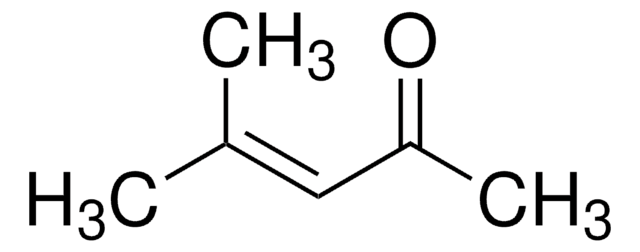67260
5-Methyl-3-heptanone
≥94% (GC)
Synonym(s):
Ethyl isoamyl ketone
Sign Into View Organizational & Contract Pricing
All Photos(1)
About This Item
Linear Formula:
CH3CH2CH(CH3)CH2COCH2CH3
CAS Number:
Molecular Weight:
128.21
Beilstein:
506345
EC Number:
MDL number:
UNSPSC Code:
12352100
PubChem Substance ID:
NACRES:
NA.22
Recommended Products
Quality Level
Assay
≥94% (GC)
refractive index
n20/D 1.414 (lit.)
bp
157-162 °C (lit.)
density
0.823 g/mL at 25 °C (lit.)
SMILES string
CCC(C)CC(=O)CC
InChI
1S/C8H16O/c1-4-7(3)6-8(9)5-2/h7H,4-6H2,1-3H3
InChI key
PSBKJPTZCVYXSD-UHFFFAOYSA-N
Looking for similar products? Visit Product Comparison Guide
Related Categories
Application
- 5-Methyl-3-heptanone can be converted into the corresponding gem-dihydroperoxide using aqueous hydrogen peroxide and chlorosulfonic acid as a catalyst at room temperature.
- It can be reduced to its corresponding alcohol using sodium borohydride in urea/choline chloride eutectic salt.
- It can undergo condensation with tert-butyl-sulfinamide to form the corresponding chiral tert-butyl-sulfinyl-ketimine, which can further react with ylides derived from trimethylsulfonium iodide and S-allyl tetrahydrothiophenium bromide to form highly substituted chiral aziridines.
Signal Word
Warning
Hazard Statements
Precautionary Statements
Hazard Classifications
Eye Irrit. 2 - Flam. Liq. 3 - STOT SE 3
Target Organs
Respiratory system
Storage Class Code
3 - Flammable liquids
WGK
WGK 1
Flash Point(F)
111.2 °F - closed cup
Flash Point(C)
44 °C - closed cup
Personal Protective Equipment
dust mask type N95 (US), Eyeshields, Gloves
Choose from one of the most recent versions:
Already Own This Product?
Find documentation for the products that you have recently purchased in the Document Library.
Natural deep eutectic salt promoted regioselective reduction of epoxides and carbonyl compounds.
Azizi N, et al.
Royal Society of Chemistry Advances, 2(6), 2289-2293 (2012)
Direct synthesis of chiral aziridines from N-tert-butyl-sulfinylketimines.
Morton D, et al.
Chemical Communications (Cambridge, England), (17), 1833-1835 (2006)
An efficient synthesis of gem-dihydroperoxides and 1, 2, 4, 5-tetraoxanes catalyzed bychlorosulfonic acid as a new catalyst.?
Khosravi K and Asgari A
JOURNAL OF ADVANCES IN CHEMISTRY, 11(3), 3381-3390 (2015)
Denis Schenkel et al.
Frontiers in microbiology, 9, 1847-1847 (2018-08-29)
The plant-growth modulating effect of microbial volatile organic compounds (VOCs) has been demonstrated repeatedly. This has most often been performed by exposing plants to VOC released by microbes grown on nutrient rich media. Here, we used soil instead to grow
Our team of scientists has experience in all areas of research including Life Science, Material Science, Chemical Synthesis, Chromatography, Analytical and many others.
Contact Technical Service









